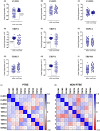Claudin and transmembrane receptor protein gene expressions are reversely correlated in peritumoral brain edema
- PMID: 39189437
- PMCID: PMC11347986
- DOI: 10.1002/cam4.70111
Claudin and transmembrane receptor protein gene expressions are reversely correlated in peritumoral brain edema
Abstract
Introduction: Peritumoral brain edema (PTBE) has been widely reported with many brain tumors, especially with glioma. Since the blood-brain barrier (BBB) is essential for maintaining minimal permeability, any alteration in the interaction of BBB components, specifically in astrocytes and tight junctions (TJ), can result in disrupting the homeostasis of the BBB and making it severely leaky, which subsequently generates edema.
Objective: This study aimed to evaluate the functional gliovascular unit of the BBB by examining changes in the expression of claudin (CLDN) genes and the expression of transient receptor potential (TRP) membrane channels, additionally to define the correlation between their expressions. The evaluation was conducted using in vitro spheroid swelling models and tumor samples from glioma patients with PTBE.
Results: The results of the spheroid model showed that the genes TRPC3, TRPC4, TRPC5, and TRPV1 were upregulated in glioma cells either wild-type isocitrate dehydrogenase 1 (IDH1) or the IDH1 R132H mutant, with or without NaCl treatment. Furthermore, TRP genes appeared to adversely correlate with the up regulation of CLDN1, CLDN3, and CLDN5 genes. Besides, the upregulation of TRPC1 and TRPC4 in IDH1mt-R132H glioma cells. On the other hand, the correlation analysis revealed different correlations between different proteins in PTBE. CLDN1 exhibits a slight positive correlation with CLDN3. Similarly, TRPV1 displays a slight positive correlation with TRPC1. In contrast, TRPC4 shows a slight negative correlation with TRPC5. On the other hand, TRPC3 demonstrates a slight positive correlation with TRPC5, while the non-PTBE analysis highlights a moderate positive correlation between CLDN1 and TRPM4 while CLDN3 exhibits a moderate negative correlation with TRPC4. Additionally, CLDN5 demonstrates a slight negative correlation with TRPC4 but a moderate positive correlation with TRPC3. Furthermore, TRPC1 have a slight negative correlation with TRPV1, TRPC3 exhibiting a slight positive correlation with TRPC4, and TRPV1 showing a slight negative correlation with TRPC5.
Conclusion: As a conclusion, the current study provided evidence of a slight negative correlation between TRPs and CLDN gene expression in PTBE patients and confirmatory results with some of the genes in cell model of edema.
Keywords: IDH; blood–brain barrier; claudin; glioma; peritumoral brain edema; transient receptor proteins.
© 2024 The Author(s). Cancer Medicine published by John Wiley & Sons Ltd.
Conflict of interest statement
The authors declare no conflict of interest.
Figures





References
-
- Liang HT, Mizumoto M, Ishikawa E, et al. Peritumoral edema status of glioblastoma identifies patients reaching long‐term disease control with specific progression patterns after tumor resection and high‐dose proton boost. J Cancer Res Clin Oncol. 2021;147(12):3503‐3516. doi:10.1007/s00432-021-03765-6 - DOI - PMC - PubMed
-
- Ishihara H, Kubota H, Lindberg RLP, et al. Endothelial cell barrier impairment induced by glioblastomas and transforming growth factor Β2 involves matrix metalloproteinases and tight junction proteins. J Neuropathol Exp Neurol. 2008;67(5):435‐448. - PubMed
MeSH terms
Substances
Grants and funding
LinkOut - more resources
Full Text Sources
Medical
Research Materials
Miscellaneous

